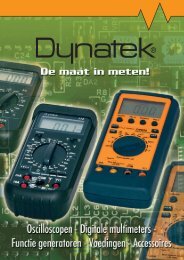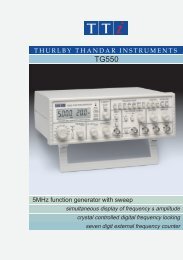TG1010A 10MHz DDS Function Generator with Arbitrary ... - ratolab
TG1010A 10MHz DDS Function Generator with Arbitrary ... - ratolab
TG1010A 10MHz DDS Function Generator with Arbitrary ... - ratolab
You also want an ePaper? Increase the reach of your titles
YUMPU automatically turns print PDFs into web optimized ePapers that Google loves.
Powerfull modulation facilities<br />
<strong>Arbitrary</strong> waveform capability<br />
Trigger/Burst<br />
All waveforms are available as a triggered<br />
burst whereby each positive edge of the<br />
Trigger signal will produce one burst of<br />
the carrier, starting and stopping at the<br />
phase angle specified by the start-stop<br />
phase setting.<br />
The number of cycles in the burst can be<br />
set between 0.5 and 1023.<br />
Single cycle burst, start-stop phase = 0 o<br />
Gated<br />
The Gated mode turns the output signal<br />
On when the gating signal is high and Off<br />
when it is low.<br />
Both Triggered and Gated modes can be<br />
operated from the internal Trigger <strong>Generator</strong><br />
(0.005Hz to 50kHz) or from an external<br />
source (dc to 1MHz).<br />
Waveform hop<br />
The generator can be set up to ‘hop’ between<br />
a number of different waveform<br />
set-ups either at a pre-determined rate or<br />
in response to a manual or bus trigger.<br />
Up to 16 different hop waveforms can be<br />
defined in terms of frequency, amplitude,<br />
function, offset and duration, which is<br />
variable in 1ms steps up to 60 seconds.<br />
Noise generation<br />
The TG1010 can be set to simulate wide<br />
band random noise <strong>with</strong> adjustable amplitude<br />
and offset.<br />
Locked generators<br />
The signals from the Clock In/Out socket<br />
and the Sync Out socket can be used to<br />
phase lock two or more generators.<br />
This can be used to generate multi-phase<br />
waveforms or locked waveforms of different<br />
frequencies.<br />
Easy and convenient<br />
to use<br />
The <strong>TG1010A</strong> is particularly easy to use.<br />
All of the main information is clearly displayed<br />
on a backlit LCD <strong>with</strong> 4 rows of 20<br />
characters. Sub menus are used for the<br />
modulation modes and other complex<br />
functions.<br />
All parameters can be entered directly<br />
from the numeric keypad. Alternatively<br />
most parameters can be incremented or<br />
decremented using the rotary encoder.<br />
Pre-programmed ‘complex’ waveform.<br />
<strong>Arbitrary</strong> waveform<br />
capability<br />
<strong>Arbitrary</strong> waveforms can be loaded via<br />
the digital interfaces and then used in a<br />
similar way to the standard waveforms.<br />
Up to five arbitrary waveforms of 1024<br />
10-bit words can be stored in non-volatile<br />
memory. The waveform clock is<br />
27.48MHz maximum.<br />
This facility considerably expands the<br />
versatility of the <strong>TG1010A</strong> making it suitable<br />
for the generation of highly complex<br />
waveform patterns.<br />
In addition, the <strong>TG1010A</strong> offers numerous<br />
“complex” waveforms pre-defined in<br />
ROM. These include commonly used<br />
waveshapes such as sine x/x, decaying<br />
sinewave, exponential rise and fall etc.<br />
Optional software is available for the creation<br />
and editing of arbitrary waveforms<br />
on a personal computer.<br />
Phase continuous frequency sweep.<br />
Amplitude modulation using the internal<br />
sine wave modulation source.<br />
Frequency shifting on alternate cycles.<br />
<strong>Arbitrary</strong> waveform - simulated contact<br />
bounce.




